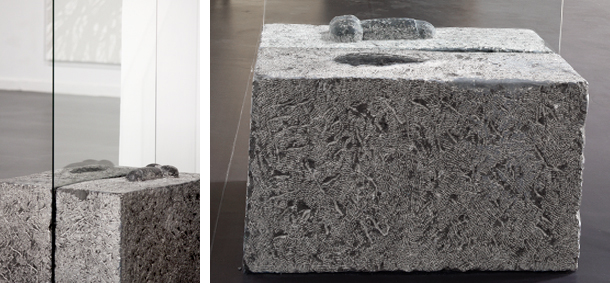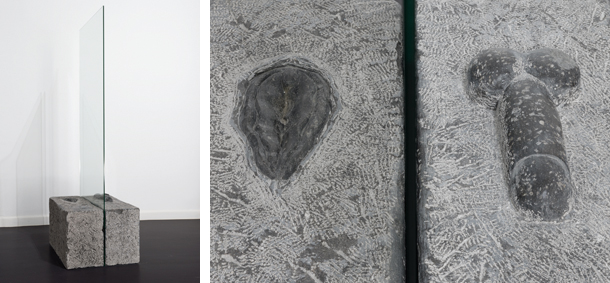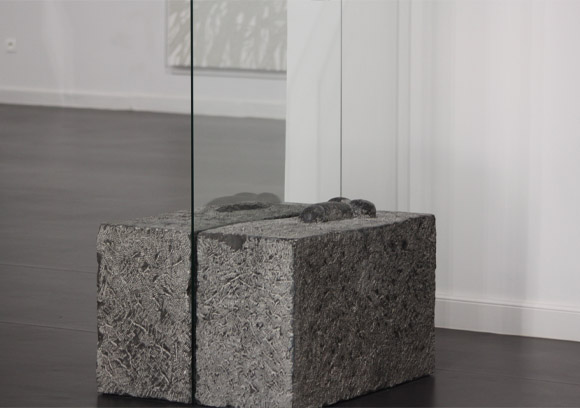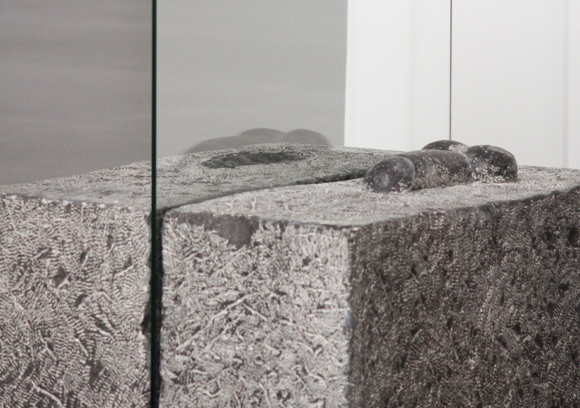| |
|
|
44.
| The Dog's House |
| |


2016, Soignies limestone, glass, 210 x 79 x 0,8 cm
Exhibition view from Depth of Field, Labanque, 2016, Bethune.
Courtesy of the artist and Ceysson & Benetiere, Paris

2016, Soignies limestone, glass, 210 x 79 x 0,8 cm
Exhibition view from Depth of Field, Labanque, 2016, Bethune.
Courtesy of the artist and Ceysson & Benetiere, Paris
'' The Dog’s House also evokes the question of preserving archeological heritage as well as the concern of the destruction
of large sites such as Timbuktu or Palmyra. ''
Studio Fatmi, December 2016

The Dog's House
Exhibition view from Depth of Field, Labanque, 2016, Bethune.
Courtesy of the artist.

The Dog's House
Exhibition view from Depth of Field, Labanque, 2016, Bethune.
Courtesy of the artist.
|
|
|
|
|
|
La Maison du Chien est une œuvre sculpturale de mounir fatmi faite de deux blocs de pierre séparés par une vitre transparente. Sur les deux blocs de pierre sont taillés en bas-relief polis, un sexe masculin et un sexe féminin, de part et d’autre de la vitre. Cette dernière, enserrée entre les deux blocs, marque une séparation de plus de 2 mètres de haut entre le féminin et le masculin. Ce dispositif induit un jeu de superposition entre les deux éléments constitutifs de la sculpture. Que l’on se trouve d’un côté ou de l’autre de la vitrine, par le phénomène de réflexion, les deux sexes se superposent.
L’appareil génital masculin a été reproduit à partir de celui du site archéologique de l’ancienne colonie romaine de Volubilis au Maroc. La présence de ce pénis indiquant l’existence de la maison des plaisirs. C’est lors de la visite du site archéologique et des explications d’un guide que mounir fatmi comprend que cette sculpture érotique est la seule de ce genre visible par le grand public dans tout le territoire marocain. Depuis sa découverte, cette ruine s’est vue polir à mesure qu’elle est devenue un véritable symbole de fertilité et de virilité à tout homme qui la toucherait. Bien que symbolique, la présence ce morceau d’histoire est menacée. Avec La Maison du Chien est aussi évoquée la question de la préservation du patrimoine archéologique ainsi que l’inquiétude face aux destructions de grands sites tels que Tombouctou ou encore Palmyre.
Pour mounir fatmi, il s’agit ici par le biais d’un mythe moderne de mettre sur un même pied d’égalité les deux sexes. Partant du constat suivant, le sexe féminin a dans l’histoire toujours été caché, voilé ou simplement absent, alors que le sexe masculin, symbole par excellence de puissance et de virilité a souvent été célébré. Cette œuvre se dresse ainsi comme une architecture représentant à elle seule les ruines de toute une civilisation revisitée, où les attributs de l’homme et la femme se font face à la même taille, au même emplacement.
Cette œuvre de mounir fatmi interroge finalement la place de la femme dans la société contemporaine.
Studio Fatmi, Decembre 2016.
|
|
The Dog’s House is a sculptural work by mounir fatmi that consists of two blocks of stone separated by a transparent glass plane. Polished bas-reliefs are carved on the two blocks of stone on either side of the glass pane, with a male sex organ on one side, and a female sex organ on the other. The pane is enclosed between the two blocks and marks a separation of over two meters in height between the feminine and the masculine. This object prompts a play of superimposition between the two components of the sculpture. Whether the spectator is on one side of the sculpture or the other, the phenomenon of reflections superimposes the two sexes.
The male sex organ was reproduced from that of Volubilis, the ancient Roman colony in Morocco. The presence of this penis indicates the existence of pleasure houses. During a visit of the archeological site and as a result of a guide’s explanation, mounir fatmi understands that this erotic sculpture is the only one of its kind visible to the general public across the Moroccan territory. Since its discovery, it has become polished by the hands that touch it as it is a symbol of fertility and virility. Although it is symbolic, this historical piece of history’s presence is threatened. The Dog’s House also evokes the question of preserving archeological heritage as well as the concern of the destruction of large sites such as Timbuktu or Palmyra.
It is in face of a modern myth that mounir fatmi places the two sexes on the same plane. He has observed that the female sex has always been hidden in history, whether it has been concealed or simply absent, while the male sex, a symbol of power and virility, has often been celebrated. This work therefore stands as a piece of architecture representing the ruins of an entire revisited civilization in which the attributes of man and woman face each other with the same size and placement.
This piece my mounir fatmi ultimately raises the issue of a woman’s place in contemporary society.
Studio Fatmi, Decembre 2016.
Traduit du français par Christina Washington. |
|
|
|